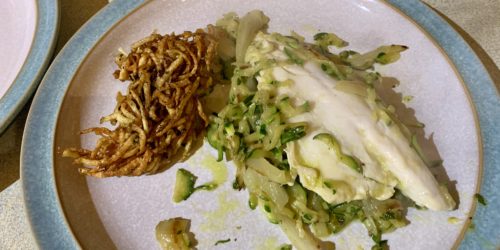Birthday lasagne
When I asked what she wanted for her (mid-week) birthday dinner, Jenny said ‘pasta’. When pressed she plumped for lasagne.
I’m not sure you’d ever find my recipe in a book anywhere. I probably developed it while at college, and have made but little change to it since. I do now add sea salt and fresh rosemary instead of mixed herbs, but the bolognese sauce is substantially the same as it was all those years ago.
For Jenny’s birthday I made the sauce the night before, as I was making the tiramisu, to allow the flavour to develop fully.
First, I gently fry the garlic and onion in olive oil, with as little stirring as you dare. The Maillard reaction is essential to good cooking, but you don’t want to burn things. I add a pinch of sea salt flakes, and then I put on my flipflops and dash outside to get some fresh rosemary.
I add dried oregano and then turn the heat up and add the mince. When this is nicely coloured it’s time to tip in a can of plum tomatoes. Waitrose essential tinned plum tomatoes are great, although we do use our own frozen passata units if it’s been a good year in the greenhouse. I wash the can out with wine—a good drinking red wine that’s been sealed and sat around since the weekend, most often, or from a bottle of Bronte Estate otherwise—mush down the tomatoes with a spatula and then stir in a tin of tomato puree.
In a pinch you can put a pan on to boil at this point, and by the time your pasta is al dente the bolognese will be edible, but only just. This time I let the sauce bubble gently for a good half hour, probably longer now I think about it, and then put the lid on the Le Creuset and turned the heat off. The pot sat there overnight.
I make my béchamel the ‘hard’, or proper way. Melt some butter and stir in enough flour to get the consistency right. Add half a teaspoon or so Coleman’s mustard powder and some ground black pepper. Slowly add full fat milk, stirring all the time, until the mixture almost boils. Do this right and you don’t need a balloon whisk to get the lumps out, because there aren’t any. Then stir in as much grated Cheddar as you like and keep stirring, making sure nothing is sticking to the bottom of the pan, until it starts bubbling. Then stop, and let it cool for a minute.
The recipes say you have to get the proportions exactly right, but I never measure anything for this. I find the recipe quite forgiving—too much butter? Add more flour and move to a bigger pan if you have to. Added too much milk? This is more difficult to rescue (if the cheddar doesn’t do it for you), but you can make a small amount of cornflour thickening and cheat.
Last week I’d made a tactical error, and used my lasagne pan for the tiramisu. So I instead used a couple of loaf tins, which actually meant we had two entire lasagnes—one to eat and one to save. (Who am I kidding? We polished the second one off at the weekend.)
Layering is controversial and a source of great stress to me. This time I put a sheet of lasagne on the bottom of the loaf tins (the sheets and the tins being apparently made for each other), then meat, béchamel, and pasta, meat, béchamel pasta béchamel. A bonus when I served it done like this was that the innards didn’t splurge all over the tin, but held together reasonably well, even when hot.
I garnished with parmesan, a sliced tomato, black pepper and sprigs of parsley. Served with caesar salad … and love.










